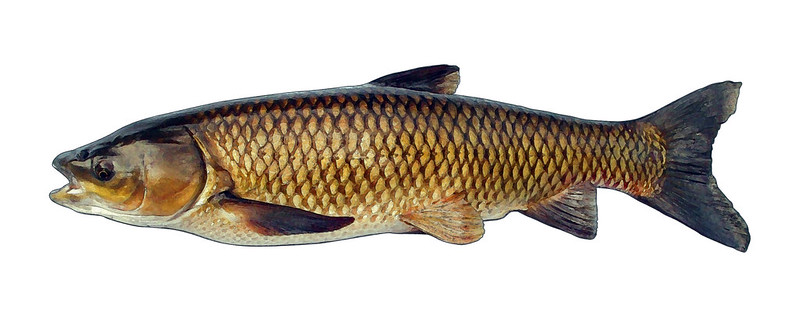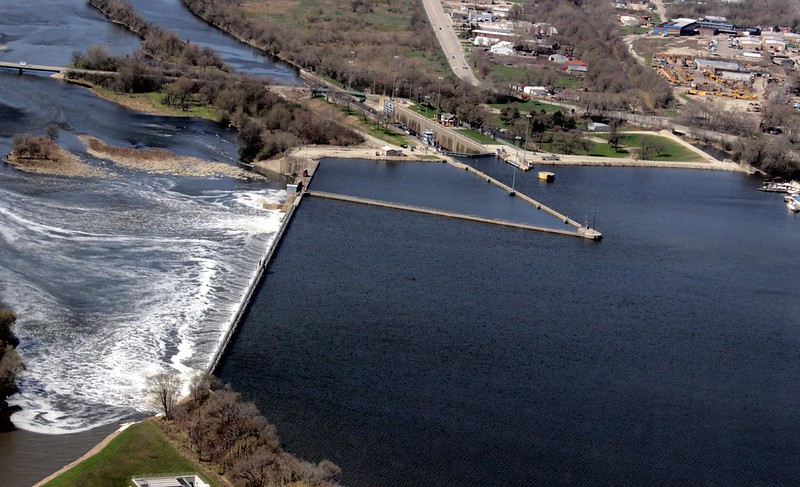Encouraging News – More Actions are Coming to Stop Asian Carp
Those fishing for a living, recalling the devastation of their Lake Trout fishery by the invasion of Sea Lampreys, are acutely aware of the present dangers posed by Asian carp entering Lake Huron and Georgian Bay. While three of the four species of Asian carp (Bighead, Black and Silver) remain blocked, Grass carp, travelling from Ohio’s Sandusky River, have been living in Lake Erie since the 1980’s.
 For years, biologists thought that Grass carp were sterile or “triploid” and, would not pose a threat to Great Lakes fisheries. However, recent catches of Grass carp in the western basin of Lake Erie and its tributaries have proven otherwise as many have been identified as “diploid” or fertile. A recent Southern Illinois University study published in the Journal of Great Lakes Research revealed the presence of a small number of fertile Grass carp beyond Lake Erie’s western basin. While most of the 153 fertile Grass carp caught between 2012 and 2018 were in Lake Erie, 21 were found in Lake Michigan, 8 in Lake Ontario, 2 from Lake Huron, and 11 in the St. Lawrence river. With their ability to spawn and their numbers potentially rising and ability to grow quickly – up to 5 feet and weights reaching 80 pounds, they could soon challenge native fish for food and destroy fish habitat by foraging on aquatic vegetation. Added to this risk is the possibility of three other species of Asian carp – Bighead, Black and Silver entering Lake Michigan from the Illinois river and travelling north into the upper Great Lakes.
For years, biologists thought that Grass carp were sterile or “triploid” and, would not pose a threat to Great Lakes fisheries. However, recent catches of Grass carp in the western basin of Lake Erie and its tributaries have proven otherwise as many have been identified as “diploid” or fertile. A recent Southern Illinois University study published in the Journal of Great Lakes Research revealed the presence of a small number of fertile Grass carp beyond Lake Erie’s western basin. While most of the 153 fertile Grass carp caught between 2012 and 2018 were in Lake Erie, 21 were found in Lake Michigan, 8 in Lake Ontario, 2 from Lake Huron, and 11 in the St. Lawrence river. With their ability to spawn and their numbers potentially rising and ability to grow quickly – up to 5 feet and weights reaching 80 pounds, they could soon challenge native fish for food and destroy fish habitat by foraging on aquatic vegetation. Added to this risk is the possibility of three other species of Asian carp – Bighead, Black and Silver entering Lake Michigan from the Illinois river and travelling north into the upper Great Lakes.
While limiting the spread of Grass carp continues as a priority, new funding and co-operation among states, provinces and federal authorities have been announced to mitigate the potential harm that Grass carp and the other three species of Asian carp could inflict on upper Great Lakes fisheries. The seven steps that follow, taken together should greatly help to address this pending threat.
- First, the Great Lakes Fishery Commission’s Lake Erie Committee (LEC) comprised of fisheries managers from three states and Ontario has developed the Lake Erie Grass Carp Adaptive Response Strategy, 2019-2023. Its purpose is to identify controls to minimize expansion, to include in-depth research for effective management actions, and to monitor and control new breeding populations of Grass carp.
- Second, the US Congress, with participation from Fisheries and Oceans Canada, recently approved $1 million for a targeted netting program in 2021 in the western portion of Lake Erie and its tributaries to determine Grass carp fertility numbers by means of environmental DNA sampling.
- Third, the Great Lakes Commission (GLC) on November 19th 2020, adopted a host of resolutions urging action to control Asian carp, including supporting the 2020 Asian Carp Action Plan an interagency, federal, provincial, and state partnership to develop new prevention and control measures to keep Asian carp out of the Great lakes.
 Fourth, on December 8th 2020 the United States House of Representatives passed the Water Resources Development Act. The bill authorizes funds for constructing various physical deterrents to improve the Brandon Road Lock and Dam – a potential entry point for Asian carp travelling upstream from the Mississippi river basin to the Great Lakes. On January 7th, 2021 Michigan and Illinois agreed to provide $10.5 million for pre-construction, engineering, and design work with the U.S. Army Corp of Engineers adding $3.8 million towards this phase. When finally completed will provide a secure protection point preventing Asian Carp entering Lake Michigan.
Fourth, on December 8th 2020 the United States House of Representatives passed the Water Resources Development Act. The bill authorizes funds for constructing various physical deterrents to improve the Brandon Road Lock and Dam – a potential entry point for Asian carp travelling upstream from the Mississippi river basin to the Great Lakes. On January 7th, 2021 Michigan and Illinois agreed to provide $10.5 million for pre-construction, engineering, and design work with the U.S. Army Corp of Engineers adding $3.8 million towards this phase. When finally completed will provide a secure protection point preventing Asian Carp entering Lake Michigan.- Fifth, the Great Lakes Restoration Initiative Act received Presidential approval on January 6th 2021 for upping current funding levels from last years’ $300M to $375M in 2022, and an additional $25M per year until hitting $475M in 2026 to fund various projects in both Canadian and American waters including improvements to control Asian carp, restore wetlands and fish habitat.
- Sixth, the Ontario and Quebec Provinces and Great Lakes state governors are continuing to work collaboratively under the Invasive Species Mutual Aid Agreement signed in 2014. An essential part of this work is to prevent the introduction and spread of aquatic invasive species; to share information, establish protocols and funding to prevent Asian carp entering the Great lakes; and, to respond in a timely manner to emergent threats from Invasive Species.
- Seventh, the Invasive Species Centre based in Sault Sainte Marie, recently received $7.47 million from the Ontario government to continue their focus on the environmental and economic risks of Asian carp, and to monitor and respond to rising levels of invasive species in the St. Mary’s River and the North Channel.
Finally, in the local waters of Georgian Bay and the North Channel, commercial and recreational anglers can be helpful watching for signs of early migrations of Grass carp from the south and reporting sightings and/or catches to the Ontario Federation of Anglers and Hunters Invading Species Hotline at 1-800-563-7711. Fisheries and Oceans Canada is also offering current information and news on their website www.asiancarp.ca about preventing, reporting and efforts to control Grass carp.
